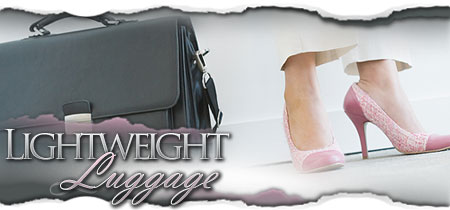
A Guide to Must-Have Lightweight Luggage
by Denise McCluggage
In
the days of steamer trunks, grand tours by rail and an abundance of porters, nobody
cared about the weight of the luggage (except perhaps the porters). Rugged durability
and good looks were what counted in those days. That meant sturdy leather, brass
fittings and locks worthy of a bank vault.
With
the norm now being air travel and do-it-yourself toting, weight ranks high on
the list of considerations when choosing luggage. Covering long gate-to-gate dashes
with your bags is relatively painless when they are on wheels, but lifting is
involved when you encounter stairs, a common occurrence if a commuter flight or
international travel is involved. And even if you roll your bag directly on board
there's that lifting it into the overhead.
What
is lightweight?
Don't just see the word in the blurb and
believe it; look for the actual weight. I put the top limit to qualify as lightweight
at nine or ten pounds for a maximum-sized carry-on (21- 22 inches long).
Although
leather is still a favorite for good looks, long life and resistance to damage,
we are dealing here with weight. Leather is heavy. So are hard-sided bags whether
ABS, aluminum or other material. If you seek lightweight look to nylon and its
various manifestations. Nylon and honeycomb frames have helped lean out luggage
while retaining ample strength and resiliency for long use.
Lightweight
luggage is available in many configurations and means of transporting it from
point A to B such as top and/or side handles; over-the-shoulder strap; backpack
straps; built-in wheels, and slip back (a wide belt that allows a smaller bag
to slip over the pull handle of a larger wheeled bag.) Most bags have a combination
of these. (I'm partial to backpacks with a grip handle at least on top that also
have a telescoping handle and wheels.)
To
meet today's travel needs with its strict limitations I suggest a baggage wardrobe
built around a core of two pieces with maybe two others added for those who do
a lot of varied traveling. All the pieces are ideally lightweight, expandable
and have wheels. (Their pull handles, by the way, should require only one hand
to open or close them and should be adjustable in length to accommodate users
from short to tall.)
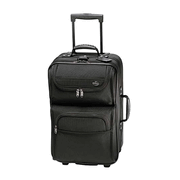 | A
22-inch upright suitcase. |
Bag
One: The basic core bag is a 22-inch upright
(sometimes called a "vertical Pullman") with inline-skate wheels and
a telescoping handle. It weighs not more than 10 pounds empty. This bag is an
overhead bin bag and the largest that can be taken aboard a plane. (International
flights may allow only 20" bags in the cabin. Always check the airline you
are using for their regulations.)
For
flexibility choose a bag that can be expanded in depth by some three inches either
by unzipping or pushing buttons. Realize that in such an expanded state the bag
is a check through only and not a carry-on.
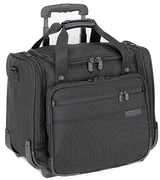 | Briggs
& Riley Baseline Baisc Rolling Wheeled Tote |
Bag
Two: This bag is for easy under-the-seat storage which means no more
than 20" and preferably less. It has wheels and telescoping handle for towing
and concealed straps for backpacking. Some designs favor the trekking style; some
look more like a vertical roll-aboard bag. My choice for a rolling backpack is
either expandable or has a piggy-backing separate daypack to add to its flexibility
of use. One pocket accepts my small laptop perfectly and is easily accessible
to keep the computer handy for removal at security checkpoints.
Other
pockets can be configured to hold a variety of electronics gadgets, business papers,
camera etc. A sweater and compact rain gear fit easily. Outer zipped pockets have
two zippers on each so they can be opened from the center thus limiting the risk
of spilled contents. A small exterior pocket offers easy access to a cell phone
and/or PDA. Another either swallows a small purse or holds the usual purse-y items.
Bag
Three: For anyone given to extended travel
requiring a wide variety of clothing I would add a larger check-through-only bag
to the luggage wardrobe to meet those needs. Wheeled of course and expandable.
There are some huge bags out there but keep in mind that anything larger than
a 30" bag when full might be hard for you to cope with alone when loading
it into ground transportation. (Prime rule of travel: never take more than you
can handle alone.)
Bag
Four: A fourth bag would be largely a sub for any of the others to
vary the possibilities. (Flexibility is a virtue equal to lightness,) Maybe this
is a 20" vertical wheeled bag for those trips on which that is the maximum
carry-on size.
Other possibilities. Consider a wheeled duffel bag (if you
favor that deconstructed style) either in carry-on or check-through size. Or a
garment bag, wheeled or over-the-shoulder. I personally was never drawn to garment
bags but some people swear by them. (Make sure they fit carry-on restrictions
when packed. Many do not.)
A
bag that appeals to me for the fourth member of a varied baggage wardrobe is the
inventive Tutto with soft sides on a fiberglass frame. This bag rolls on four
wheels like a wagon instead of being dragged on two wheels. The four wheels on
the ground support all of the bag's weight and thus takes less effort to tow.
The easy-to-handle Tutto is friendlier to the less than robust traveler, the arthritic or the
merely weary.
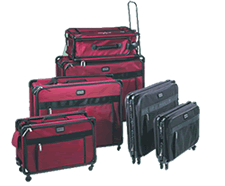 | Tutto
Luggage |
The
ingenious Tutto, which comes in various sizes and outfitted for a range of specific
uses such as a rolling office and a pet carrier (!) collapses to just three inches
deep for storage. The emphasis on lightweight in luggage does not mean any sacrifice
of style, but it can mean some compromises with longevity unless you choose the
more expensive and hardier fabrics (such as Dupont's Cordura or ballistic nylon.)
Actually the price of luggage rather well reflects its quality.
Details
to check: zippers not too close to the edge where they are vulnerable.
A #10 coiled nylon zipper is strong and will not open if a tooth is broken. Check
for tight, double stitching and handles that are fastened with multiple rivets.
Straps should be padded and reinforced where they are fastened to the bag. Protective
covers on corners add weight but are useful for longevity.
To make the
right choice of lightweight luggage and decide how much to pay to get
what you want consider several things:
•
Do you travel closer to twice a week, or to twice a year?
•
Do you always carry your bag aboard or do you check it through?
•
Do you use a number of bags or always the same one?
•
Do you like to keep up with the latest luggage trends or are do you prefer to stay the tried and
true?
Frequent travelers need sturdy luggage to withstand the rigors of
the road, particularly if the bag is sometimes conveyed through those flapping
strips into the unknown world of baggage handling.
If
you travel infrequently or use a number of different bags and always roll them
aboard then you can manage with less sturdy fabrics and thus less expensive bags.
Some travelers prefer variety to quality anyway. They would rather pay less for
a bag and buy new ones more often. They can thus change colors, style or models.
Yes, the expensive bags will likely last longer, but if you're one who thinks
that might be boring then bargain shop and take your chances. (Look for sales
and Internet deals.)
Either way, it behooves the luggage shopper to know what
makes one bag cost more than another and how to spot those details.
Put
two bags side-by-side — same size, color and appearance yet one costs
two to three times more than the other. Why?
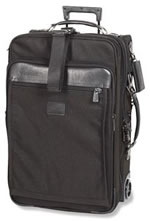 | Andiamo
Valoroso
Two Suit Journeyman Carry-On Garment Bag -- made with DuPont Bomb-Cloth
ballistic nylon. |
Read
the tags:
The less expensive one may be made of, 600 dernier Polyester. The other may
be 1000 denier Cordura, a special Dupont nylon used extensively in luggage since
the 1970s. Maybe it is a ballistic nylon. More expensive fabric
promises far better wear quality.
If
a trademarked name you no not recognize is used for a fabric ask a knowledgeable
salesperson. Or type that name in a good search engine such as Google.com. If
you do you'll find, for instance, that Dukktex is a polyester fabric that Skyway
uses a lot in its inexpensive though nicely featured luggage. However polyester
is not high on the list of durable fabrics for heavy use.
The
most serious enemy of a soft-sided bag is abrasion, and a bag gets lots of constant
rubbing in the rough and tumble of use. Punctures and slashes are rarer but serious
factors in damage. Cordura resists abrasion, puncture and general wear extremely
well. Ballistic nylon performs as well or better and is smoother and less attractive
to dust and lint. (Ballistic nylon got its name from its use with Kevlar
in bulletproof vests.) Polyester is less durable.
The
denier (sometimes represented as "d") is a measure of the fineness of
a fabric. The higher the denier the stronger it is. An oft-mentioned rule of thumb
is to look for a minimum of 600-1800 denier polyester toward the least expensive
end of the curve and 500-1000 denier Cordura or 1800 to 2500 denier ballistic
nylon at the more expensive end. (Andiamo uses something called "bomb cloth",
a mix of Cordura and ballistic nylon, in one of its lines. It is stronger on wear
quality than on lightness.)
When
comparing bags in a store, read the tags to see what they are made of. Read the
warranties to see what sort of damage is covered and not covered. On the Internet
(suggested sources are listed below) note that some sites carry more detail than
others. Some don't include a bag's weight. If they do not assume that lightness
is not a selling point. Most bag manufacturers (another list below) have websites.
Do your
homework, find styles and sizes that suit your needs, settle on a manufacturer or specific item
and then surf the web or the mall to find the best price.
Some
manufacturers to consider: Skyway; Tutto; Travelpro; Samsonite; Atlantic, Briggs
& Riley; Eagle Creek; Swiss Army; Jourdan; JanSport; American Tourister; High
Sierra; Traveler's Choice; Tumi; Atlantic; Andiamo.
Some
Internet sources for luggage: www.ebags.com;
www.magellans.com; www.travelsmith.com;
www.irvsluggage.com; www.luggageonline.com;
www.worldtraveler.com;
www.luggage-and-leather.com.
A
simple approach is to go to Yahoo.com,
click on "shopping" and type in the search window what you are looking
for, i.e. "wheeled backpacks," "lightweight luggage" for selection from many sources.
Note:
When choosing the color of your new bag realize that red is
the new black! It seems it struck everybody at the same time that red would stand
out at the baggage claim. Colorful tags or baggage straps are still the best way
to spot your bag.
|